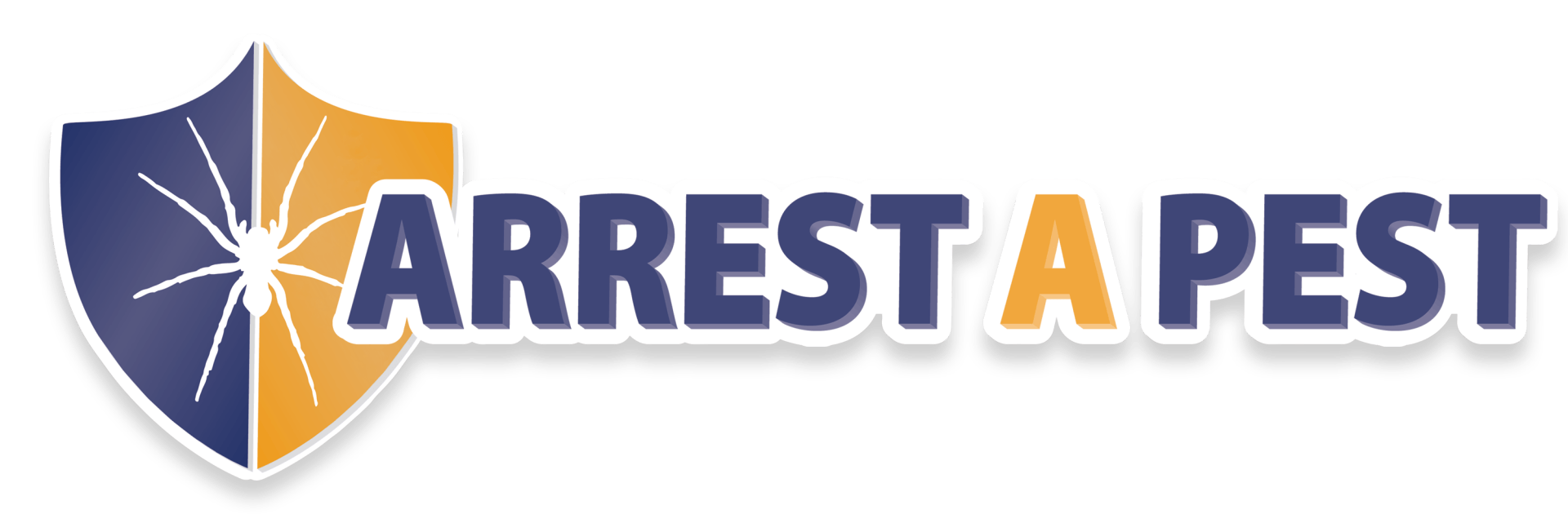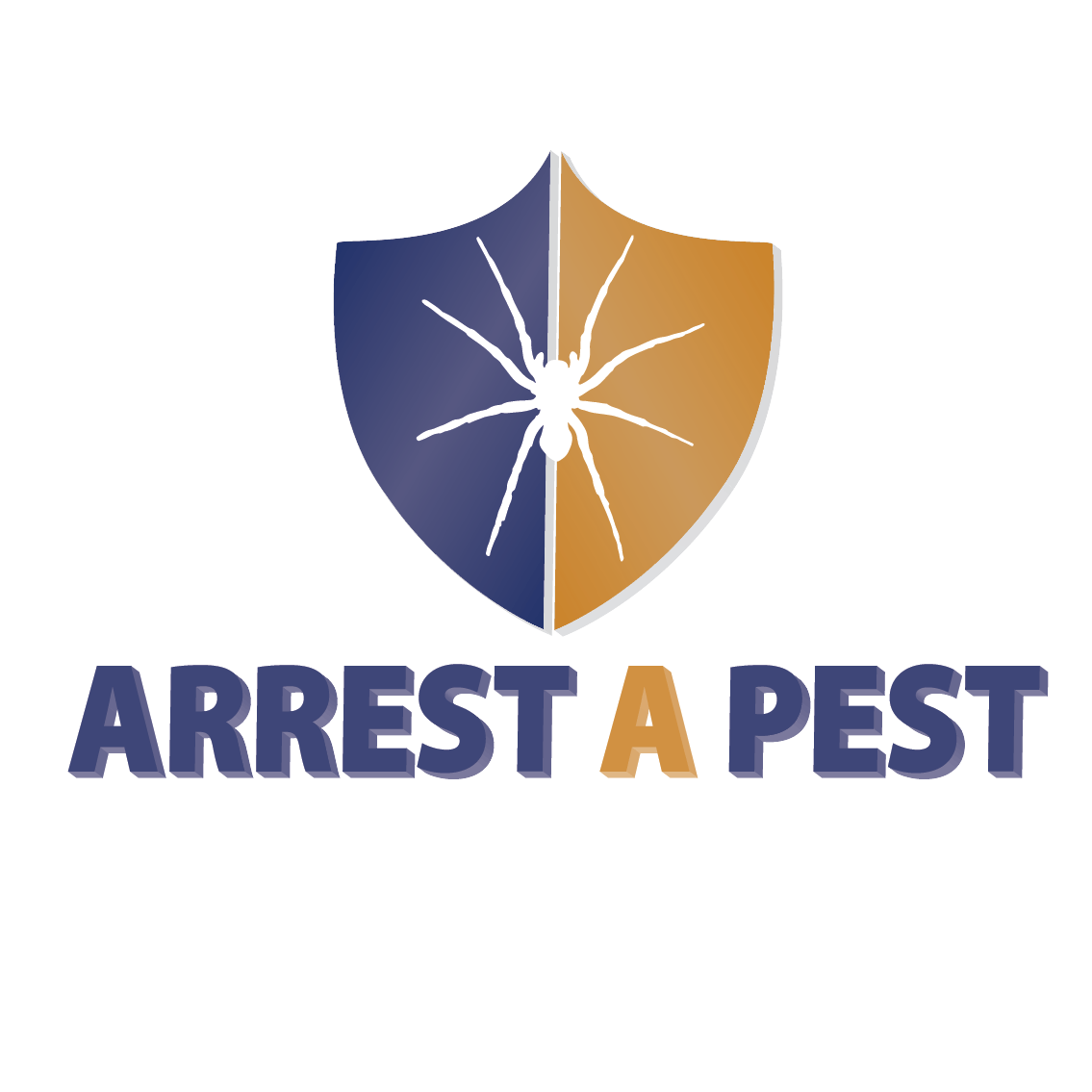Ants
Ant Control
Information on Pest Control for Ants
Having a ant problem? Check below to find out facts on types of ants to help you get started on containing the issue.
The Quick Information On Ants
Having a ant problem? Check below to find out facts on types of ants to help you get started on containing the issue.
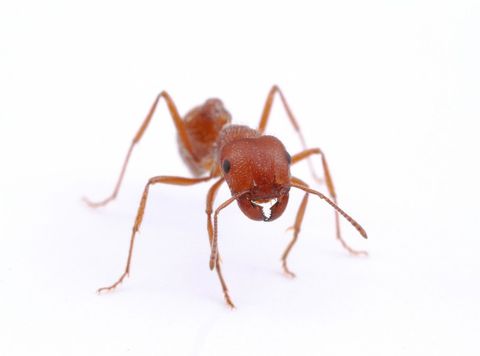
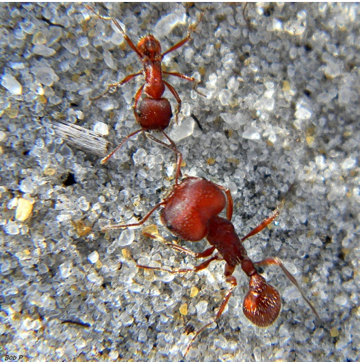
HARVESTER ANT
Latin Name: Pogonomyrmex badius
Alias:Red Ant
Threat Level:High
Descriptions:
- Harvester ants are a dark rust color, and have very large heads. These ants prefer to nest in sandy soil in exposed areas. They are very passive but their stings are very hurtful, among some of the most painful ant stings. Harvester ants collect the seeds from plants and store them in their nests.
Locations:
- The Harvester ant is commonly found in a range of Florida to Mississippi to North Carolina.
Control Methods:
- Baiting can be used to help control Harvester ants. Ant mounds should be treated by injecting insecticide dust into them, best if at the hottest part of the day, as they are less active then.
Other Info:
- Harvester ants are polymorphic, meaning there is multiple sizes of workers.
- Harvester ant’s colonies can bud
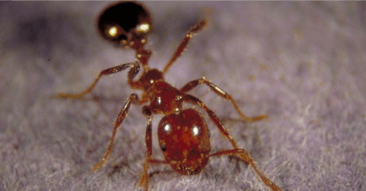
RED IMPORTED FIRE ANT
RED IMPORTED FIRE ANT
Latin Name:
Alias:
Threat Level: High
Descriptions:
- Red Fire Ants are a reddish brown color, with a darker abdomen. Workers come in many sizes. They aggressively attack the offender when their neat id disturbed, and they have a very painful stinger.
Locations:
- Fire Ants typically nest outdoors in sunny areas of soil, but they are also attracted to electrical junction boxes, air conditioners, gas and water meters. They follow pipes into the buildings.
Control Methods:
- Some control methods include putting chemical directly on the mound. Pouring chemical toxic to ants, watering chemical dust, and spraying pressurized insecticide into and on the mound are some ways, although they may not be effective in reaching the queen. Baits are another way to treat and can be used as broadcast and individual mound application.
Other Info:
- The Red fire ant is native to South America
- Their colonies can have single or multiple queens
- Their bites can cause a variety of reactions, from small pain and swelling to anaphylactic shock.

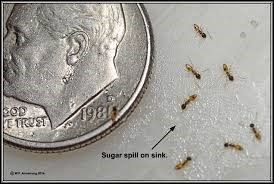
GHOST ANT
Latin Name: Tapinoma melanocephalum
Alias: Invisible Ant, Tramp Ant
Threat Level: Low. They can be a nuisance if in your house.
Descriptions:
- Very small with a dark head and milky white/opaque gaster and legs
Locations:
- Can be seen in kitchens and bathrooms on the counters, floors and sinks.
Control Methods:
- One method of control in the home is cleanliness. Food particles can feed and attract Ghost Ants, so use tightly stored containers. Remove plants that may attract Ghost Ants and try to reduce moisture sources. If using baiting, use non-repellent bait. If ants don’t feed on the bait, try relocating it to a new area, like one of their main walkways.
Other Info:
- A Ghost Ant’s Gaster can change color based on what it eats

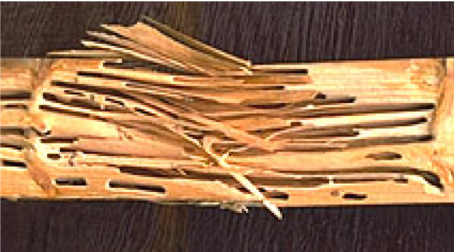
CARPENTER ANT
Latin Name: Camponotus
Alias: Bull Ant
Threat Level: Carpenter ants damage wood structures. They also bite and spray formic acid.
Descriptions:
- Coloring from red-orange head and black gaster to all black. Will also have wings. There exist 3 types of Carpenter ants in the U.S, and are among the largest of ants. Finding a ½” long carpenter ant is not uncommon.
Locations:
- Carpenter Ants can be found in walls, kitchens, bathrooms, or other areas with high moisture, and sometimes in electrical boxes. They can live in many places. Outside, they can live in rotting trees, old wooden decks, bamboo poles, and other similar areas with dead or decaying wood.
Control Methods:
- Treating Nest directly is preferable. Since Carpenter ants can hide in walls, dust can be used to treat known nest locations. Sometimes the nest is unable to be found, so bait is used. Trees and electrical wires can serve as bridges, so trim trees and shrubbery touching the house. Have a professional treat wires or perhaps put pest barricades. Caulk any cracks in the exterior. Since these can forage hundreds of feet from their nests, multiple inspections and treatments may be needed to eliminate them from the property.
Other Info:
- Carpenter ants are often mistaken for Termites due to their wood tunneling habits
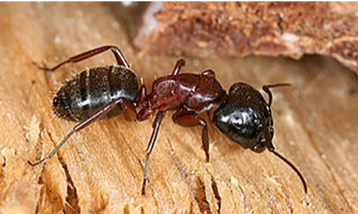

CARPENTER ANTLatin Name: Camponotus
Alias:Bull Ant
Threat Level: Carpenter ants damage wood structures. They also bite and spray formic acid.
Descriptions:
- Coloring from red-orange head and black gaster to all black. Will also have wings. There exist 3 types of Carpenter ants in the U.S, and are among the largest of ants. Finding a ½” long carpenter ant is not uncommon.
Locations:
- Carpenter Ants can be found in walls, kitchens, bathrooms, or other areas with high moisture, and sometimes in electrical boxes. They can live in many places. Outside, they can live in rotting trees, old wooden decks, bamboo poles, and other similar areas with dead or decaying wood.
Control Methods:
- Treating Nest directly is preferable. Since Carpenter ants can hide in walls, dust can be used to treat known nest locations. Sometimes the nest is unable to be found, so bait is used. Trees and electrical wires can serve as bridges, so trim trees and shrubbery touching the house. Have a professional treat wires or perhaps put pest barricades. Caulk any cracks in the exterior. Since these can forage hundreds of feet from their nests, multiple inspections and treatments may be needed to eliminate them from the property.
Other Info:
- Carpenter ants are often mistaken for Termites due to their wood tunneling habits

CRAZY ANT
Latin Name: Paratrechina longiconis
Alias:
Threat Level:
Low
Descriptions:
- Dark brown to gray body, with a very long antennae and legs compared to body.
Locations:
- Crazy ants can nest in trash, rotten wood, cavities in trees, and soil.
Control Methods:
- If crazy ants are found in walls, drill and inject insecticide dust. Apply baits along foraging trails and suspected nest sites. For outdoor control, try caulking cracks and weather stripping.
Other Info:
- Crazy Ants collect honeydew from aphids
- They often appear to be lost or confused, due to their erratic movements
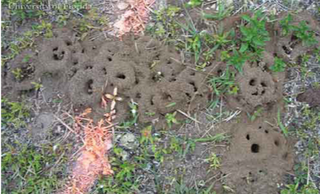
BIG HEADED ANTLatin Name: Pheidole megachephala
BIG HEADED ANT
Latin Name: Pheidole megachephala
Alias:None
Threat Level:
Low
Descriptions:
- Big Headed ants can be light to dark reddish brown. Major workers head is very big in proportion to their bodies. Some will have wings. They leave displaced sand and dirt piles from digging, they are a soil-nesting ant. The typical Bigheaded ant will be 1/8” long.
Locations:
- Big headed ants prefer to nest in protected soil. When they nest in open areas, they make small mounds or crawl into termite damaged wood. They usually don’t forage far from the nest, and their foraging trails are sometimes covered in soil.
Control Methods:
- If you find Bigheaded ants living in soil, treat each ant colony directly. If found in walls, drill and inject insecticide dust. If the ant colonies are not found, baiting suspected areas of activity or foraging trails is used. Big headed ants are often looking for high protein foods, so a (unclear) ant bait around the perimeter of structure is advisable.
Other Info:
- Workers are dimorphic (meaning major and minor)
- Has been one of the world’s most in invasive species of ants.
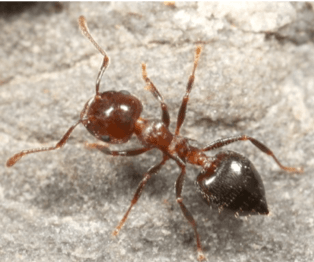
ACROBAT ANT
Latin Name: Crematogaster ashmeadi Emery
Alias: None
Threat Level:
Low/Nuisance
Descriptions:
- Acrobat Ants have very shiny bodies and vary from light red to brownish black. This ant has a heart-shaped gaster when viewed from above, and are known to raise it high above their head when disturbed. The Acrobat ant also possess a stinger and let off a terrible smell when disturbed.
Locations:
- Acrobat ants are arboreal, and so they like to live in trees and rotten wood, moving into abandoned galleries. They don’t usually live indoors, but may forage there. When Acrobat ants are found in homes, it’s typically in damp wood, foam board, insulation, or rotting wood.
Control Methods:
- Acrobat ants can be treated by removing dead logs or stumps, sealing cracks into home, and removing branches that touch the house. When in walls, drill and inject dust. Most pest control professionals can treat for these ants. A perimeter spray will help control the acrobat ant. Well placed baits can also be a good tool. Level of control difficulty: Easy
Other Info:
- They are called acrobat ants because of their flexibility of their bottoms. Which they turn up in when disturbed.

ACROBAT ANTLatin Name: Crematogaster ashmeadi Emery
Alias: None
Threat Level:
Low/Nuisance
Descriptions:
- Acrobat Ants have very shiny bodies and vary from light red to brownish black. This ant has a heart-shaped gaster when viewed from above, and are known to raise it high above their head when disturbed. The Acrobat ant also possess a stinger and let off a terrible smell when disturbed.
Locations:
- Acrobat ants are arboreal, and so they like to live in trees and rotten wood, moving into abandoned galleries. They don’t usually live indoors, but may forage there. When Acrobat ants are found in homes, it’s typically in damp wood, foam board, insulation, or rotting wood.
Control Methods:
- Acrobat ants can be treated by removing dead logs or stumps, sealing cracks into home, and removing branches that touch the house. When in walls, drill and inject dust. Most pest control professionals can treat for these ants. A perimeter spray will help control the acrobat ant. Well placed baits can also be a good tool. Level of control difficulty: Easy
Other Info:
- They are called acrobat ants because of their flexibility of their bottoms. Which they turn up in when disturbed.
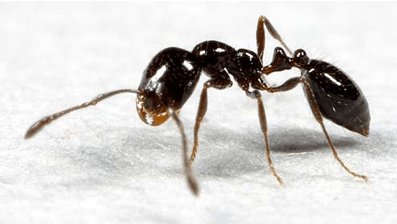
LITTLE BLACK ANT
Latin Name: Monorium minimum
Alias: None
Threat Level:
Low
Descriptions:
- Some of the smallest ants, they are black and only 1/16 of an inch big. Little black ants also have a shiny luster to their bodies.
Locations:
- Indoors, little black ants can be found in decaying wood and woodwork. Outside, they are found in soil, nesting under dark, damp places like rocks or decaying wood. Pavement ants live throughout the United States.
Control Methods:
- Locate pavement ant nests by following foraging trails and treating it. Since they are very small, pavement ants can enter the house through small cracks, so seal all the gaps and cracks. To help control ants outside, remove any piles of firewood or bricks to eliminate possible nesting areas.
Other Info:
- The little black ant has a stinger, but it’s usually too small and too weak to be effective.
- Pavement ants have medium to large sized colonies, with up to two queens.
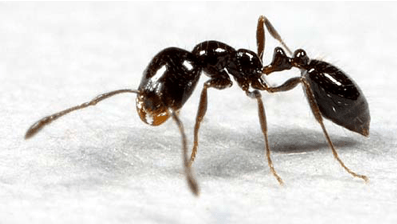
LITTLE BLACK ANTLatin Name: Monorium minimum
Alias: None
Threat Level:
Low
Descriptions:
- Some of the smallest ants, they are black and only 1/16 of an inch big. Little black ants also have a shiny luster to their bodies.
Locations:
- Indoors, little black ants can be found in decaying wood and woodwork. Outside, they are found in soil, nesting under dark, damp places like rocks or decaying wood. Pavement ants live throughout the United States.
Control Methods:
- Locate pavement ant nests by following foraging trails and treating it. Since they are very small, pavement ants can enter the house through small cracks, so seal all the gaps and cracks. To help control ants outside, remove any piles of firewood or bricks to eliminate possible nesting areas.
Other Info:
- The little black ant has a stinger, but it’s usually too small and too weak to be effective.
- Pavement ants have medium to large sized colonies, with up to two queens.
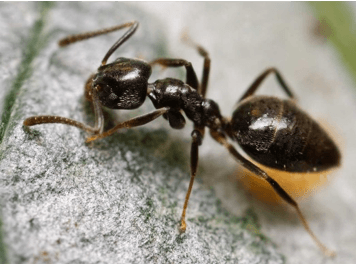
ODOROUS HOUSE ANT
Latin Name: Tapinoma sessile
Alias: None
Threat Level:
Low/Nuisance
Descriptions:
- Odorous house ants are brown or black and can be identified by the smell they emit when crushed, a rotten coconut or blue cheese smell. The ants range in size from 1/8” to 1/16”.
Locations:
- Odorous house ants live throughout North America. Outside, these ants live in soil beneath logs, stones, mulch, etc. Inside, they live in walls around pipes, heaters, under sinks, and under the floor.
Control Methods:
- Baiting foraging trails is one means of controlling Odorous house ants. Look for baits that are made specifically for sugar loving ants. Using insecticide dust to treat crevices can also help destroy ant colonies.
Other Info:
- The odorous house ant is native to North America
- Odorous house ants forage both day and night

ODOROUS HOUSE ANTLatin Name: Tapinoma sessile
Alias: None
Threat Level:
Low/Nuisance
Descriptions:
- Odorous house ants are brown or black and can be identified by the smell they emit when crushed, a rotten coconut or blue cheese smell. The ants range in size from 1/8” to 1/16”.
Locations:
- Odorous house ants live throughout North America. Outside, these ants live in soil beneath logs, stones, mulch, etc. Inside, they live in walls around pipes, heaters, under sinks, and under the floor.
Control Methods:
- Baiting foraging trails is one means of controlling Odorous house ants. Look for baits that are made specifically for sugar loving ants. Using insecticide dust to treat crevices can also help destroy ant colonies.
Other Info:
- The odorous house ant is native to North America
- Odorous house ants forage both day and night
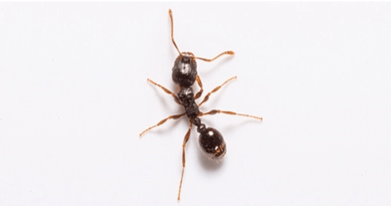
PAVEMENT ANT
Latin Name: Tetramorium caesptium
Alias: None
Threat Level:
Low
Descriptions:
- Pavement ants range from deep brown to black and have long, sculpted lines running down their body. Pavement ants are about 2.5-4 mm long. They also possess a stinger.
Locations:
- This ant prefers to live with low amounts of vegetation, making them like urban areas.
Control Methods:
- Baits are a good option, since Pavement ants feed in swarms. In case of severe pavement ant infestation drilling and injection below concrete may be necessary. Since pavement ants are attracted to moisture, remove all standing water around the home.
Other Info:
- These ants like living under pavement, sidewalks, and patios, as the name Pavement ant suggests.
- Pavement ants try to take over other colonies, and as a result huge ant battles occur.
- The queen and swarmer Pavement ants are twice as big as the worker ants

PAVEMENT ANTLatin Name: Tetramorium caesptium
Alias: None
Threat Level:
Low
Descriptions:
- Pavement ants range from deep brown to black and have long, sculpted lines running down their body. Pavement ants are about 2.5-4 mm long. They also possess a stinger.
Locations:
- This ant prefers to live with low amounts of vegetation, making them like urban areas.
Control Methods:
- Baits are a good option, since Pavement ants feed in swarms. In case of severe pavement ant infestation drilling and injection below concrete may be necessary. Since pavement ants are attracted to moisture, remove all standing water around the home.
Other Info:
- These ants like living under pavement, sidewalks, and patios, as the name Pavement ant suggests.
- Pavement ants try to take over other colonies, and as a result huge ant battles occur.
- The queen and swarmer Pavement ants are twice as big as the worker ants
PHARAOH ANT
Latin Name: Monomoruim pharaonsis
Alias: None
Threat Level:
High
Descriptions:
- Pharaoh ants have a pale yellowish to reddish body, with darker shading on gaster. Pharaoh ants require lots of water. They forage for water as well as food, sometimes aggressively. These ants harvest water from unusual places, like from pet dishes, aquariums, and house plants.
Locations:
- Pharaoh ants like warm, humid, and secluded places to nest, such as between linens and under floors.
Control Methods:
- In order to successfully treat Pharaoh ants, a complete area must be treated, including walls, ceilings, floors, and electrical outlets. Non-repellant ant baits must be paced on foraging trails.
Other Info:
- Pharaoh ants can get into a lot of things, and have even infested hospitals, transmitting diseases to infants and burn patients
- Pharaoh ants can forage in the wound of sick and infirm patients.
- Pharaoh ants can split up their colonies in a process called budding

PHARAOH ANTLatin Name: Monomoruim pharaonsis
Alias: None
Threat Level:
High
Descriptions:
- Pharaoh ants have a pale yellowish to reddish body, with darker shading on gaster. Pharaoh ants require lots of water. They forage for water as well as food, sometimes aggressively. These ants harvest water from unusual places, like from pet dishes, aquariums, and house plants.
Locations:
- Pharaoh ants like warm, humid, and secluded places to nest, such as between linens and under floors.
Control Methods:
- In order to successfully treat Pharaoh ants, a complete area must be treated, including walls, ceilings, floors, and electrical outlets. Non-repellant ant baits must be paced on foraging trails.
Other Info:
- Pharaoh ants can get into a lot of things, and have even infested hospitals, transmitting diseases to infants and burn patients
- Pharaoh ants can forage in the wound of sick and infirm patients.
- Pharaoh ants can split up their colonies in a process called budding
Click on the links below to visit some of our industry partners
PHONE
316.945.8400
© ARREST A PEST. License Number 7113
This Website Is Powered By Silvergear© ARREST A PEST. License Number 7113
